Bne-Binyamin Cooperative Bank was founded in 1924 to help farmers succeed in the Land of Israel. At the time, the regular commercial banks offered loans to farmers at 9 percent, while this bank offered an interest rate of 7 percent. One of its leaders was journalist Itamar Ben-Avi—the son of Eliezer Ben-Yehuda, who revived the Hebrew language. But even with the favourable terms, clients fell behind on payments, and the bank couldn’t continue functioning. In September 1939 the British Mandate Banks Examiner issued an order to liquidate Bne-Binyamin. This share certificate was designed by Meir Gur-Arie, who taught at the Bezalel art academy in Jerusalem, and who in 1923 helped design Jerusalem’s YMCA.
This archive collects David Matlow’s 100 weekly social media instalments published from February 2021 to February 2023. You can search this website for more pieces from the Treasure Trove.

Herbert Samuel (1870-1963) was England’s Postmaster General in January 1915 when he prepared a memorandum to the cabinet called “The Future of Palestine.” It proposed that the British conquer it, in order to establish a Jewish centre as part of the British Empire. Five years later, Samuel (who was Jewish and a Zionist) became the first High Commissioner for Palestine, which put him in charge of administering the territory: the appointment was controversial because Zionists saw him as the first step in the formation of the Jewish national home; the Arab population was critical for the same reason. This letter from Samuel in Hebrew—one of the three official languages for the territory he recognized—gives thanks for the warm wishes he received upon his return to Israel.
Find more from David Matlow at herzlcollection.com

Dov Gruner (1912-1947) was a member of the Irgun, the pre-state Jewish paramilitary group that operated in Palestine during the British Mandate, which he joined after serving in the British army fighting the Nazis. Wounded in a raid against a police station, he was captured and charged—and his trial before a British military court began on Jan. 1, 1947. Gruner refused to recognize the authority of the court because the British betrayed their commitment to help establish the Jewish homeland. “There is no power in the world which can sever the tie between the Jewish people and their one and only land,” he said. Refusing to offer a defence or accept any commutation, Gruner was hanged in Acre prison together with three colleagues on April 16, 1947.

Doar Ivri (“Hebrew Post”) was the inscription on Israel’s first postage stamps, because they were printed before the country’s name was known. Never before had a state prepared its first stamps without knowing the name it would eventually adopt. They were prepared in secret because doing so was illegal while the British were still in the country. The stamps featured ancient Hebrew coins to emphasize the connection of the Jewish people to their ancestral homeland, and tabs were added on the bottom row of each sheet to translate the inscription on the coin: this one from the second year of the first rebellion (against the Romans, 66-70 C.E.) says “shekel of Israel, holy Jerusalem.” Israel was declared on Friday, May 14, 1948, and post offices sold the stamps by Sunday. It was the first tangible sign that the Jewish state had been born.

Milk and Honey opened on Broadway on Oct. 10, 1961. The musical ran for 543 performances and received five Tony nominations. Looking to mount a theatrical production about Israel, producer Gerard Oestreicher sent book writer Don Appell and composer Jerry Herman on a trip there in search of inspiration. The story centers on a busload of American widows touring the country while it struggles for recognition as an independent nation. The musical’s song “Shalom, Shalom” was all about the uniqueness of the word:
It means a million lovely things
Like peace be yours
Welcome home
And even when you say goodbye
You say goodbye with Shalom
This was the Broadway debut for 30-year-old Jerry Herman, who went on to compose scores for Hello, Dolly!, Mame and La Cage aux Folles.
Find more from David Matlow at herzlcollection.com

The Levant Fair was an international industrial trade exposition during the 1930s in Tel Aviv—in 1934, it hosted 820 international companies and 600,000 visitors. The fair incorporated the local industrial exhibitions first organized in 1923 by Alexander Yevzerov (1894-1973), a Siberian Zionist who immigrated to Palestine with the vision of making Israel an industrial powerhouse. He established Mischar ve Taasya(Trade and Industry Publishing and Exhibition Co.) to organize these fairs, publish economic magazines (like this one) and promote buying local products (totzeret haaretz). Yevzerov built the Binyanei HaUmahnational conference center in Jerusalem in 1950, to make Israel’s capital a center for commerce, industry and culture. Yevzerov also changed his name to Ezer, meaning help—something which he certainly did.

Nathan Alterman (1910-1970) was born in Warsaw and moved to Tel Aviv when he was 15. He was a poet and weekly columnist for the Labour Movement’s newspaper, Davar, who David Ben-Gurion referred to as “the conscience of the nation.” Responding to Chaim Weizman’s warning that “the state will not be given to the Jewish people on a silver platter” on Dec. 19, 1947, Alterman published his poem “Magash HaKesef” (“The Silver Platter”), which captured the sacrifice necessary to create the state. In it, two battle weary soldiers declare: “We are the silver platter on which the Jewish state was given,” words repeated annually on Israel’s Remembrance Day. Alterman is honoured by appearing on the 200 shekel banknote.

Eliezer Ben-Yehuda (1858-1922) died a century ago on Dec. 16—but his legacy lives on in the Hebrew language. Motivated to reject the diaspora lifestyle and establish a means for Jews from all backgrounds to communicate, he set out to make Hebrew the language of everyday communication. Despite complaints by some that the holy language should not be used for mundane purposes, he compiled its first modern dictionary. It required coining many words from relevant sources (for instance, ice cream is glida, from the Aramaic word for “frost”). No other examples exist of a language without any native speakers becoming a national language. This postcard from the 1920s with his picture describes Ben-Yehuda as “the reviver of the Hebrew language and its use.”

General Sir Edmund Allenby (1861-1936) commanded the British Army’s Egyptian Expeditionary Force in the First World War. He led the conquest of southern Palestine including Gaza and Beersheva before capturing Jerusalem in December 1917, which ended nearly 500 years of Ottoman or Turkish rule. When he arrived in Jerusalem, Allenby rode his horse to the Jaffa Gate, then dismounted to enter the Old City on foot out of respect for the holiness of the site—in contrast to Germany’s Kaiser Wilhelm who in 1898 rode into the city on a white horse. Allenby worked with Jerusalem’s community leaders to ensure that the religious sites of all faiths were protected. Allenby Junior Public School in Toronto’s Lawrence Park neighbourhood, which opened in 1931, is named in his honour.
Find more from David Matlow at herzlcollection.com

The Partition Resolution that recommended the creation of Jewish and Arab states in Palestine was passed on Nov. 29, 1947, at what had been the New York City Pavilion at the 1939 World’s Fair. It was then the temporary home of the United Nations and is now the Queens Museum—which has a plaque at the entrance recognizing this momentous event. Israeli author Amos Oz described his father’s telling him that night: “From the moment we have our own state, you will never be bullied just because you are a Jew and because Jews are so-and-sos. Not that. Never again. From tonight that’s finished here. Forever.” Israel’s Declaration of Independence says, “This recognition by the United Nations of the right of the Jewish people to establish their state is irrevocable.”

The World Cup of Soccer opens in Qatar on Nov. 20—and soccer fans can fly directly from Ben Gurion Airport to Qatar to watch the games! Canada is one of the 32 teams competing, having qualified for only its second time. (Go Canada!) Israel competed in the World Cup only once—as one of the 16 teams in Mexico 1970. Placed in a group with Uruguay, Sweden and Italy, the tournament organizers ensured Israel was not in a group with Morocco—which threatened to forfeit rather than play the Israeli team. Israel’s performance was very respectable, losing to Uruguay 2-0, and tying Sweden 1-1 and Italy 0-0 (Italy lost to Brazil in the final). Mordechai Spiegler, who scored that one goal, later played alongside Pelé on the New York Cosmos of the North American Soccer League.

Pierre van Paassen (1895-1968) was a Dutch immigrant to Canada who became a world-famous foreign correspondent for the Toronto Star from 1931 to 1936. Fluent in German, he reported on the Nazis and exposed the policies of Hitler’s fascist regime—which led to the Star becoming the first North American newspaper to be banned from Germany: Van Paassen was expelled after being imprisoned for several weeks. One of the most fervent non-Jewish Zionists of his time, he wrote books and articles that reflected his enthusiastic support of Zionism including The Forgotten Ally which was a sharp indictment of Britain’s anti-Zionist policy, published in 1943. Three years later the book was banned by the British in Mandatory Palestine.

George Meltz was born in Toronto as the youngest of 10 children to Nathan and Rachel Meltz. He enlisted in the Canadian Army in September 1940, and shipped out to England one year later. It was there that he married Trudy Lewis of London, and trained for Operation Overlord—the invasion of Nazi occupied Western Europe. It was on D-Day, June 6, 1944, that Bombardier George Meltz was one of 160,000 Allied troops who stormed the beaches of Normandy. One month later he was killed by a sniper at age 25, and was buried at the Canadian Military Cemetery at Juno Beach, France. On his gravestone is written “HE DIED SO JEWRY SHALL SUFFER NO MORE.” George Meltz and the other soldiers who fought for our freedom are our true treasures.

The Balfour Declaration was the Nov. 2, 1917, statement of the British Government that it views “with favour the establishment in Palestine of a national home for the Jewish people.” Lord Arthur Balfour, the author of those words, toured Palestine in 1925 at the invitation of Zionist leader Chaim Weizmann. He attended the ceremonial opening of the Hebrew University in Jerusalem, and was welcomed throughout his tour with great honour and ceremony by the Jewish population—including at Tel Aviv’s Gymnasium Hebrew school, which is depicted in this postcard. But the Arab population greeted Balfour with strikes and protests; after Palestine, he traveled to Damascus where he was greeted by a hostile crowd of 6,000. A riot ensued. Fearing for his safety, Balfour ended his trip to Syria early, and returned home. (Watch original footage of this visit on YouTube.)

Kaiser Wilhelm II, the German emperor, visited Jerusalem from Oct. 29 to Nov. 4, 1898, in what was the focal point of his tour of the Holyland. The arrangements for the visit were entrusted to the Thomas Cook travel agency, who set up a 230-tent camp for the Kaiser and his entourage. To ensure that Wilhelm II’s carriages could enter the Old City, a portion of the wall at the Jaffa Gate was removed—a gap that exists to this day. While in Jerusalem, he dedicated the Lutheran Church of the Redeemer, donated funds for the purchase of the land on which the Bikur Holim Hospital was built, visited the German Colony (which is pictured in this postcard) and received a Zionist delegation led by Theodor Herzl. (An exhibit of artifacts from David’s collection of Herzl memorabilia is now on at Beth Tzedec Congregation, 1700 Bathurst St., Toronto. Admission is free.)

“Free Soviet Jews” was expressed on this pin as part of the international effort to free Jews caught behind the Iron Curtain. The movement started after Israel’s miraculous victory in 1967’s Six Day War, when a number of Russian Jews applied to move to Israel. Their applications were refused, and these “refuseniks” were persecuted for merely making the attempt. A cry for Russia to let our people go to Israel was expressed through press releases, signs, banners, protests and rallies—including an annual one on Simchat Torah. “The 35s” (a group of Canadian women around that age) specialized in gaining media attention for the cause until the Iron Curtain fell in 1991. At that time, said Wendy Eisen, a Canadian leader in the movement: “One million Jews began their 2000-year journey home… to burst brilliantly onto the landscape of Jewish history.”

“Gift from Israel” is inscribed on the base of this etrog holder, whose green colour was typical of the metal crafts that became a tourist favourite in the 1950s and ‘60s. Maurice Ascalon, a Hungarian immigrant, developed the chemical process that created the green patina that gave these items an aged, archaeological look. Before regular steamship service from New York to Palestine started in 1867, the etrogs (citroen) used in North America for the Sukkot holiday came from Corsica, the Caribbean and the United States. Within a decade, the first etrogs from the Land of Israel arrived in New York. Since then, most etrogs sold in North America come from Israel—and they often end up in holders like this one.

West London Synagogue issued two sets of 50 trading cards on Jewish themes in the early 1960s. “Jewish Symbols and Ceremonies” includes cards depicting a mezuzah, a Kiddush Cup and tefillin. This card is from the second set, “Jewish Life in Many Lands,” which shows Jonah—who had been swallowed by a whale pictured exiting to the left—calling the people to repent for their sins. The back of the card explains that “we read the story of this prophet on the afternoon of Yom Kippur because repentance is the main message of this holy day.” I hope that Treasure Trove did not offend anyone this past year, and if it did, for that I seek your forgiveness. Wishing everyone an easy fast, and may your name be sealed in the Book of Life for the coming year.

Altneuland (“Old-New Land”) is a utopian novel by Theodor Herzl, first published in October 1902. The author shares his vision of the New Society to be built in the ancient land, and he anticipates a vigorous democracy, communal farming, free health care and education, equal rights for all, a seven-hour work day and scientific developments that benefit the world. Herzl’s title was translated (by Nahum Sokolov) as Tel Aviv—the city is named after the book. This 2015 edition includes Hebrew, Arabic, Russian, Amharic and English translations in a volume published by Noar HoOved VeHaLomed (“Working and Studying Youth”): it’s an Israeli movement with young Jewish, Arab and Druze members who are dedicated to the equality of human value, democracy, Zionism, peace and social justice.

The Hebrew Publishing Company of New York issued a set of 116 postcards in 1910, which included this Jewish New Year greeting that featured a polar bear in front of an American flag planted at the North Pole. The image celebrates how Robert Perry became the first person to reach it on April 6, 1909, having been accompanied on this expedition by his assistant Matthew Hanson, and four Inuit men. While there is no connection between a polar bear and Rosh Hashanah, it gives Treasure Trove the opportunity to wish everyone in the Great White North a year of warmth, adventure and peace.
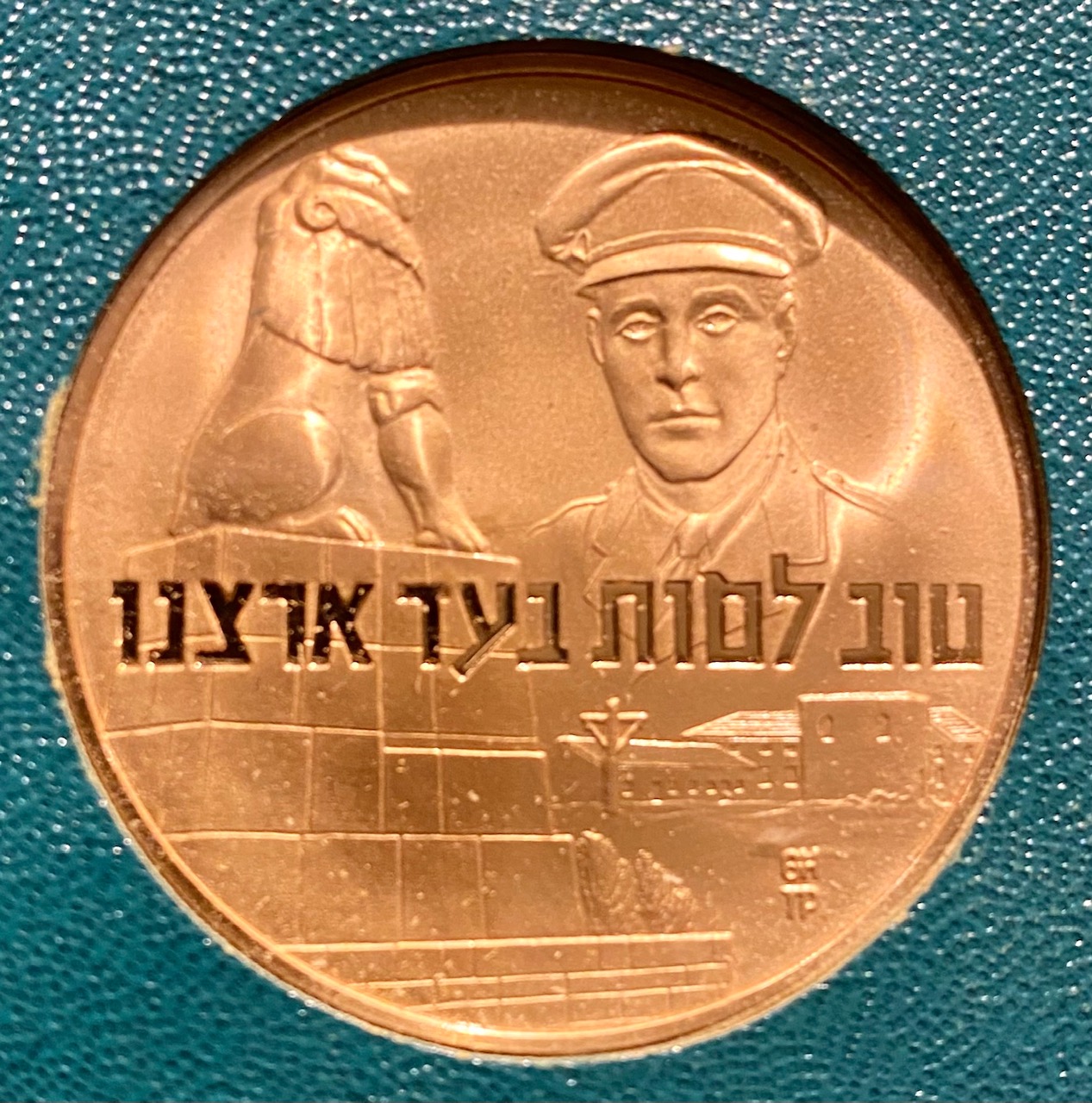
Joseph Trumpeldor (1880-1920) was a Zionist national hero who died with seven others defending the Tel Hai village in the Upper Galilee. The town of Kiryat Shmona (“City of Eight”) is named after these eight heroes. Born in Russia, he lost his left arm in the Russo-Japanese war. After later moving to Palestine, he served in the Zion Mule Corps, an all-Jewish unit in the British Army in the First World War. “It is good to die for our country,” Trumpeldor reportedly said after being fatally shot defending Tel Hai—a quote that appears on this medal minted in 1970 for the Medallic History of the Jewish People. Betar—the Revisionist Zionist youth movement—is an acronym for Brith Yoseph Trumpeldor (“The covenant of Joseph Trumpeldor”). Betar was also the last Jewish fort to fall in the Bar Kokhba revolt of 136 C.E.

The National Library of Israel was founded in 1892 in Jerusalem as the Midrash Abarbanel Library. It moved to the Mount Scopus campus of the just opened Hebrew University as the renamed “Jewish National and University Library” in 1925—the year the picture in this “magic lantern” slide was taken. When the campus was cut off from the rest of the city in 1948, the collection was smuggled into other areas of Jerusalem: 12 years later, it was reunited with the dedication of a new facility on the University’s Givat Ram campus. A new building near the Knesset will hold over 5 million books when it opens in 2023. The library will continue to fulfill its mission to collect and preserve the knowledge, heritage and culture of Israel and the Jewish people, and endow these treasures to this and future generations.

The National Library of Israel was founded in 1892 in Jerusalem as the Midrash Abarbanel Library. It moved to the Mount Scopus campus of the just opened Hebrew University as the renamed “Jewish National and University Library” in 1925—the year the picture in this “magic lantern” slide was taken. When the campus was cut off from the rest of the city in 1948, the collection was smuggled into other areas of Jerusalem: 12 years later, it was reunited with the dedication of a new facility on the University’s Givat Ram campus. A new building near the Knesset will hold over 5 million books when it opens in 2023. The library will continue to fulfill its mission to collect and preserve the knowledge, heritage and culture of Israel and the Jewish people, and endow these treasures to this and future generations.

The First Zionist Congress was held in Basel, Switzerland, from Aug. 29-31, 1897, with 208 delegates from 17 countries and 26 members of the press in attendance. Adopted there was the Basel Prgram, which set the goal of the newly established Zionist movement to be “to secure for the Jewish people a publicly recognized, legally assured homeland in Palestine.” Theodor Herzl convened it as a parliament of a state in creation: “In Basel, I created the Jewish State,” he proudly declared—and insisted all delegates wear tuxedos for the occasion, as depicted in this postcard. There were 22 Zionist Congresses across Europe prior to Israel’s independence, but they’ve been exclusively in Jerusalem since 1951. Find more from David Matlow at herzlcollection.com.

Labour Zionism (Poale Zion) envisioned a progressive society constructed in Palestine by a Jewish working-class—one which could also serve as a new model for humanity. At its fifth North American convention, held in Montreal in 1910, delegates resolved to establish a secular Yiddish-based school system across North America. This postcard shows the newspaper and tobacco store of Henry (Hirsh) Hershman on the Main (St. Lawrence Blvd.), which was festively decorated to welcome delegates. Hershman also opened Montreal’s first Jewish library in his house—as the precursor to the Jewish Public Library—along with being a pioneer of the Jewish press, and a founder of the Peretz School and the Canadian Jewish Congress.

The Eternal Road was an epic musical drama that ran in the Manhattan Opera House for 153 performances in 1937. At the time, it was the largest, most grandiose and costly production ever mounted in New York. Produced by Max Reinhardt, with music by Kurt Weill and script by Franz Werfel (all three were German-Jewish refugees) the production had three purposes: to respond to Germany’s state sponsored persecution of Jews, to relate the historical wandering and suffering of the Jewish people through bibilical stories, and to suggest that a Jewish homeland is the alternative to 2,000 years of the “eternal road” of helplessness. For the last performance Reinhardt proclaimed: “The light that we lit together… will shine undimmed in the history of the theater and of the Jewish people.”
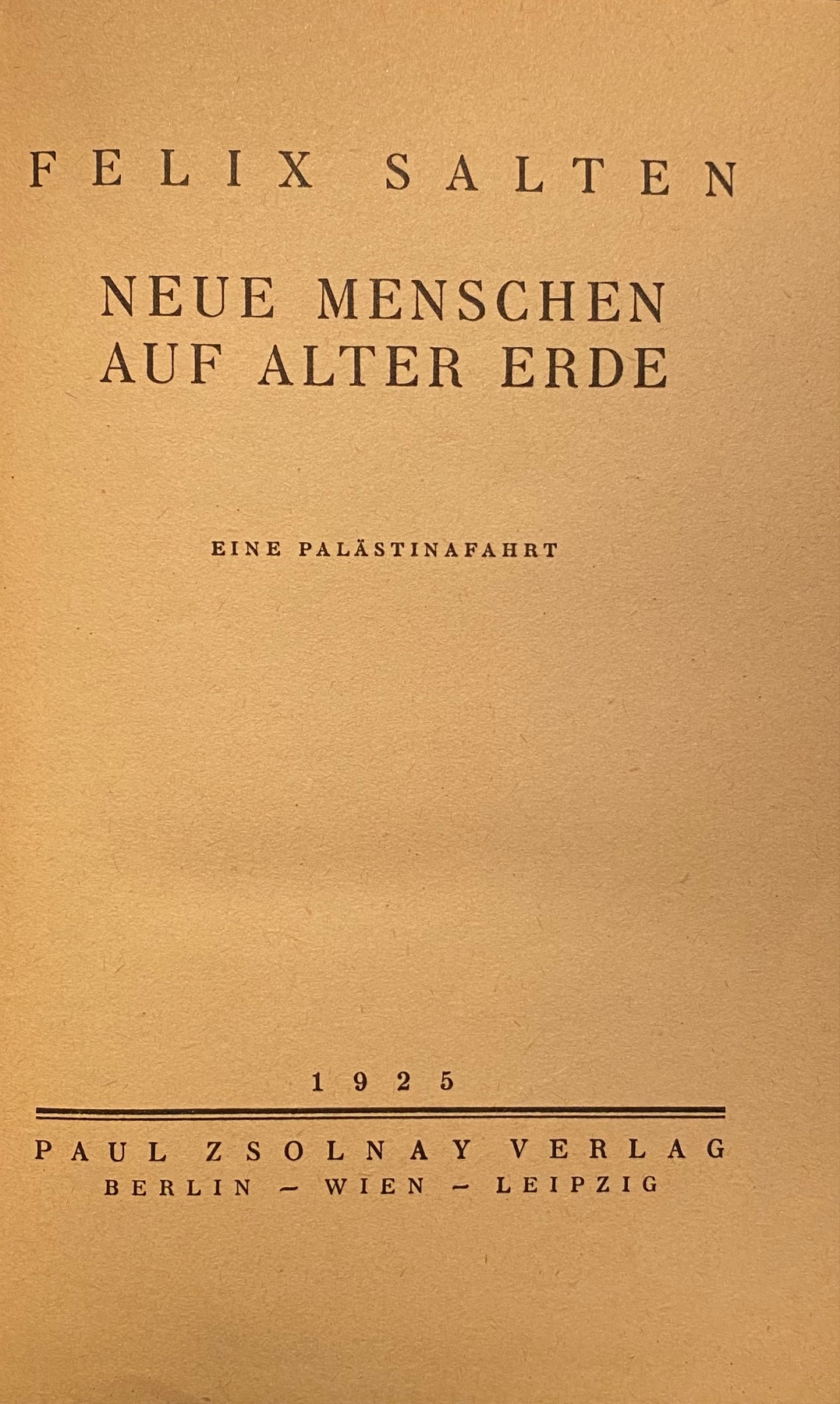
New People on Ancient Soil by author Felix Salten is based on his visit to Palestine and is a tribute to the dream of a Jewish state of his friend Theodor Herzl, who Salten credits with inspiring him to embrace his own Jewishness. He is better known for the 1923 book Bambi: A Life in the Woods, the inspiration for Disney’s fifth animated feature, which premiered 80 years ago this week. An outdoorsman and naturalist—and, ironically, also a hunter—Salten wrote Bambi as a plea for greater care for and understanding of the world of nature, yet some commentators suggest it’s a parable about Jewish persecution. When the Nazis seized Austria he fled to Switzerland, where he died in 1945.
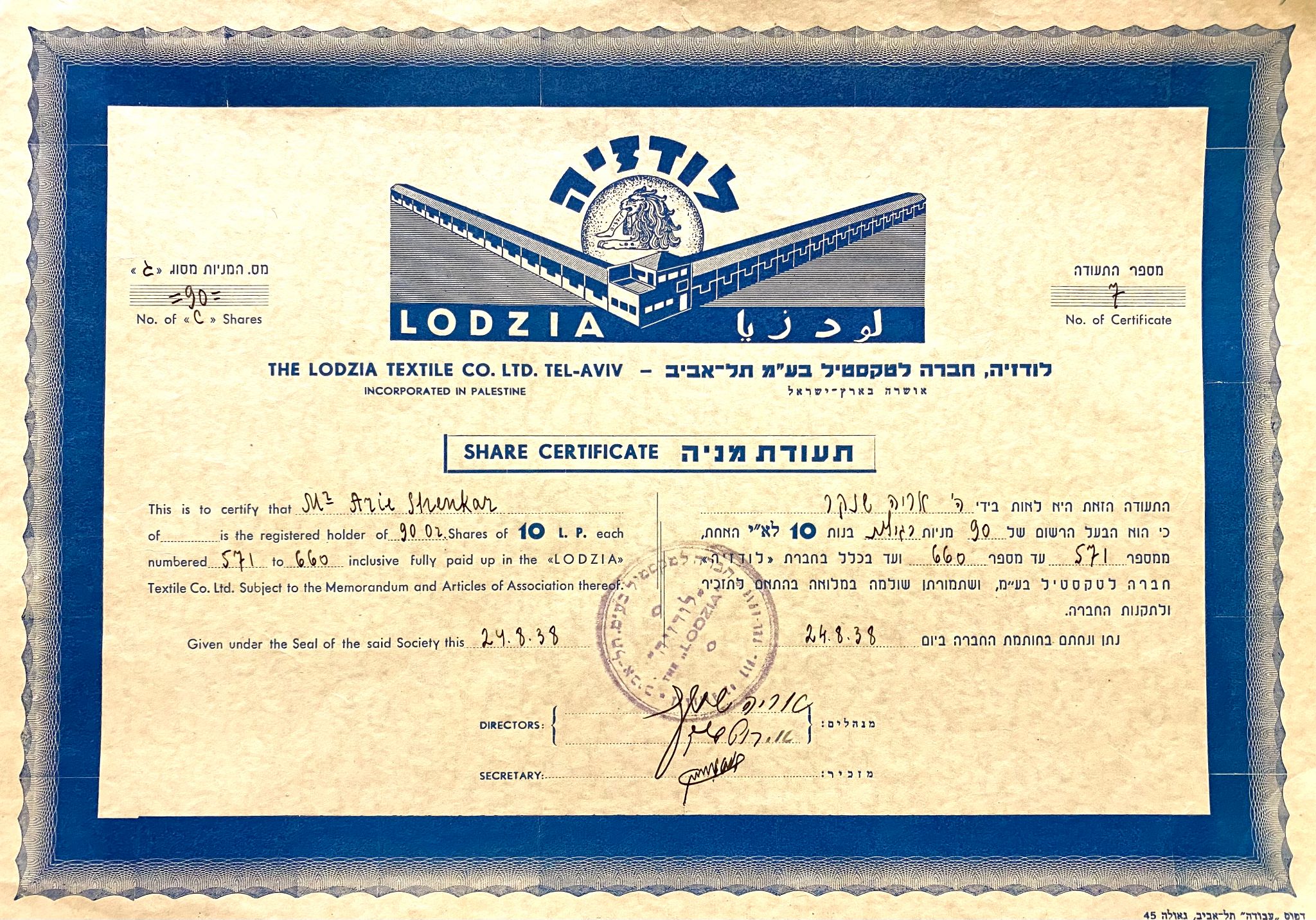
Aryeh Shenkar (1877-1959) was one of the founders of the Hovevei Zion (Lovers of Zion) movement in Ukraine. He moved from Russia to Palestine in 1924 and bought the Lodzia textile factory—whose workers originated in the Polish town of Lodz. It became profitable while he promoted the local textile industry and other manufacturers. For 29 years, he served as the president of the Industrialists’ Union in the Land of Israel (later the Manufacturers Association of Israel), and Ramat Gan’s Shenkar College of Engineering, Design and Art was named after him. This is his 1938 share certificate for 90 common shares of The Lodzia Textile Co. Ltd. The Lodzia business was acquired by Israeli public company Delta Galil in 2014.

The Monteith Inn was a 150-room hotel on Muskoka’s Lake Rosseau, a two-and-a-half-hour drive north of Toronto. Harry and Jennie Shopsowitz—the founders of Shopsy’s Delicatessen, which started as an ice cream parlour in Toronto’s garment district—purchased the property for $25,000 in 1935. It was one of the local “Jewish resorts” (along with Muskoka Lodge in Huntsville, Gateway Hotel in Gravenhurst, and Smith’s Bay House, Arcadia Lodge and Taub’s Lodge in Port Carling) that thrived because Jews weren’t welcome elsewhere. When the Monteith opened, a one-week all-inclusive stay cost $14. This 1937 advertisement promotes kosher meals by a famous chef from Miami. The Shopsowitz family operated the hotel until 1949. (The next year, it was destroyed by a fire.)
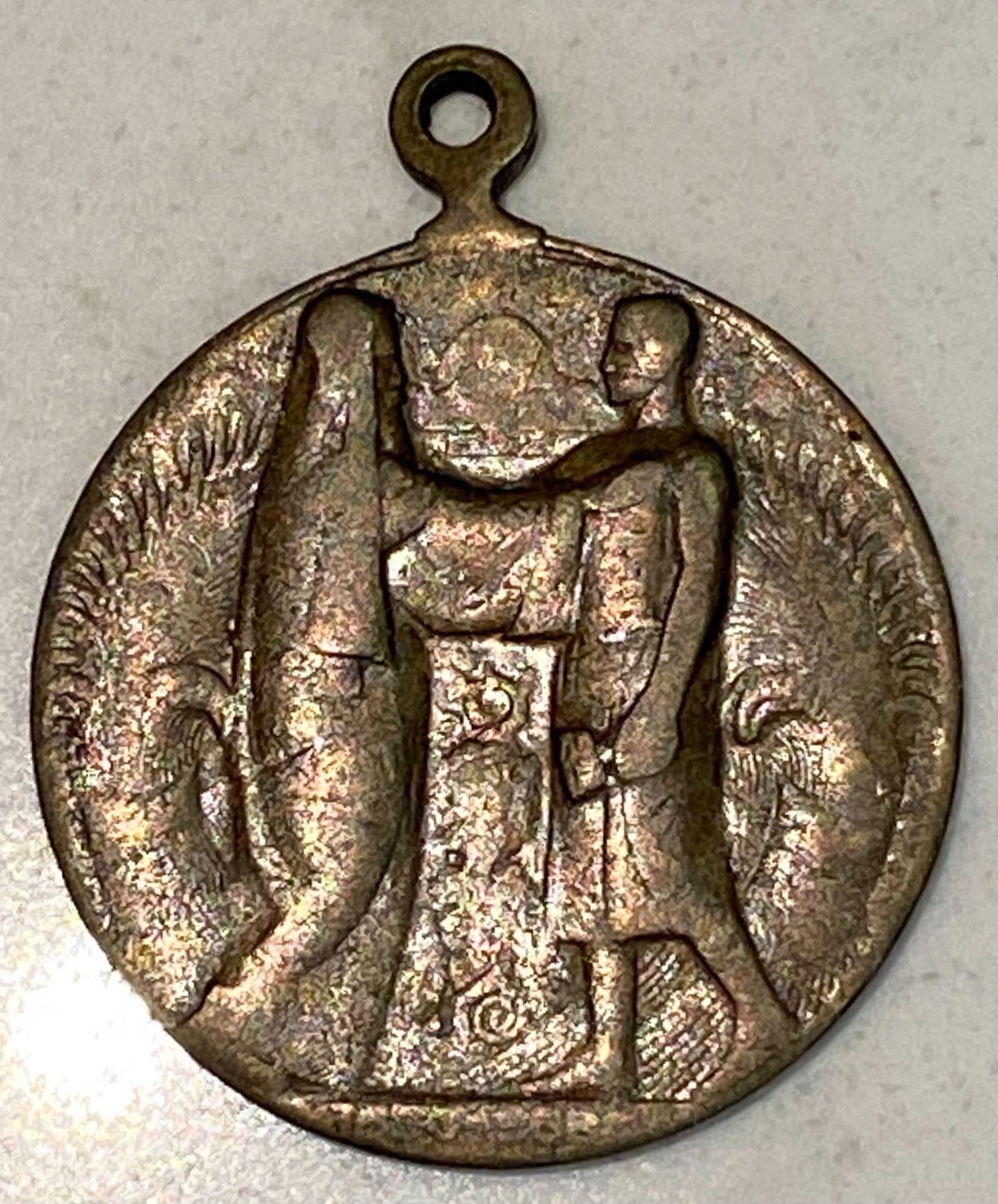
July 24, 1922 is the date when the League of Nations—predecessor to the United Nations—resolved to establish the British Mandate, which gave recognition “to the historical connection of the Jewish people with Palestine and to the grounds for reconstituting their national home in that country.” Great Britain became responsible for preparing conditions “as will secure the establishment of the Jewish national home.” The resolution was unanimously approved by all 51 member nations (all League resolutions required unanimity). It implemented the agreement reached at the San Remo conference two years prior, commemorated on this 1920 Dutch-minted medal, which depicts a hammer-wielding modern pioneer meeting an ancestor from the time of the destruction of the Second Temple.

“Land of Promise” was part of the Wild Man trading card series produced by the Bowman Gum Company in 1950. The set recorded the story of humanity from cavemen and Vikings to falconry and civil aviation. (One card and one piece of gum cost a penny.) A total of 72 cards were issued, including this one with this text on the back: “We live in an age of stirring events, one of which is the founding of the new nation of Israel. Thousands of Jewish people, many of whom suffered terrible persecution during World War II, are returning to Palestine, their ancestral home. By work of hands and brain, they are determined to build an Israel worthy of its glorious heritage.” Now this card is a keeper.
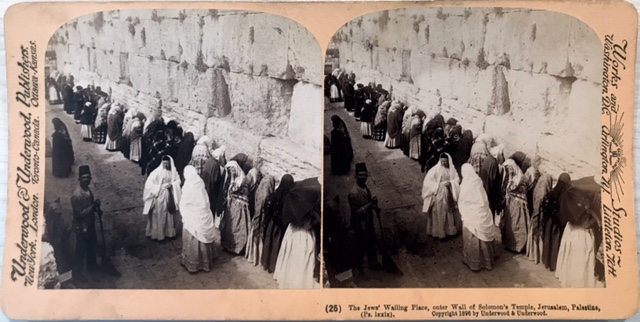
The Western Wall is seen on this stereoscopic card with a picture (actually two pictures—you’re not seeing double) capturing how “the outer wall of Solomon’s Temple” appeared in Jerusalem in 1896. Produced by Underwood & Underwood, the largest publisher of stereoviews in the world—with an office in Toronto—it was designed to be placed in a viewing device called a stereoscope and appear as a three-dimensional image. The card’s reverse quotes Psalm 79 in English, French, German, Spanish, Norwegian and Russian: “How Long, Lord? Wilt Thou Be Angry Forever?” There are several hundred of these cards of Palestine, which enabled people to see the Holy Land at a time when a trip to the region was costly and difficult.
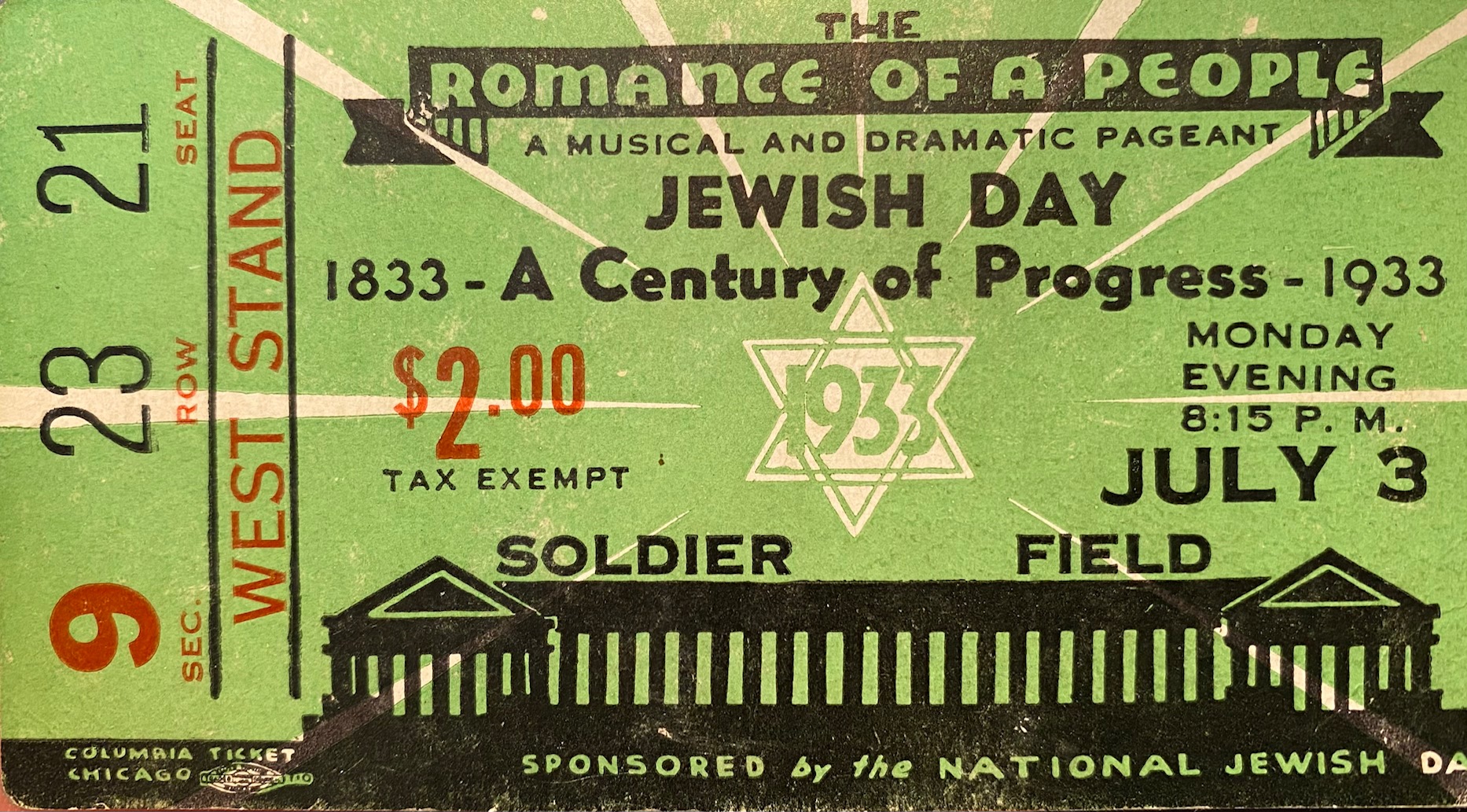
The Romance of a People historical pageant was performed before 125,000 people at Chicago’s Soldier Field on Jewish Day at the 1933 World’s Fair. With its depiction of 4,000 years of Jewish history from Abraham to the pioneers in Israel, the event was a fundraiser to resettle German Jews in Palestine. To ensure a large audience, organizer Meyer Weisgal included schools and youth groups among the 6,000 performers—rightly concluding that parents and grandparents would attend. The show helped raise the profile of Zionism in Chicago and unified its Jewish community. After a four-day run at New York’s Polo Grounds was rained out, it ran for 20 performances at an indoor location instead and raised an additional $100,000 for German Jewry. (The equivalent of $2.1 million today.)

The American Colony was a Christian utopian society formed in Jerusalem in 1881 by Horatio and Anna Spafford who left Chicago for the Holyland in search of peace after a series of personal tragedies. Colony members lived a communal life and engaged in philanthropic work benefiting all religions—like a soup kitchen and an orphanage. The group purchased a curio store just inside the Jaffa Gate of the Old City, which was renamed the American Colony Store. Profits supported the group through the sale of images, souvenirs, artifacts and archaeological objects. The community dissolved in the 1950s, but one of its communal residences became the American Colony Hotel in East Jerusalem, which remains owned and operated by descendants of the original founding community.
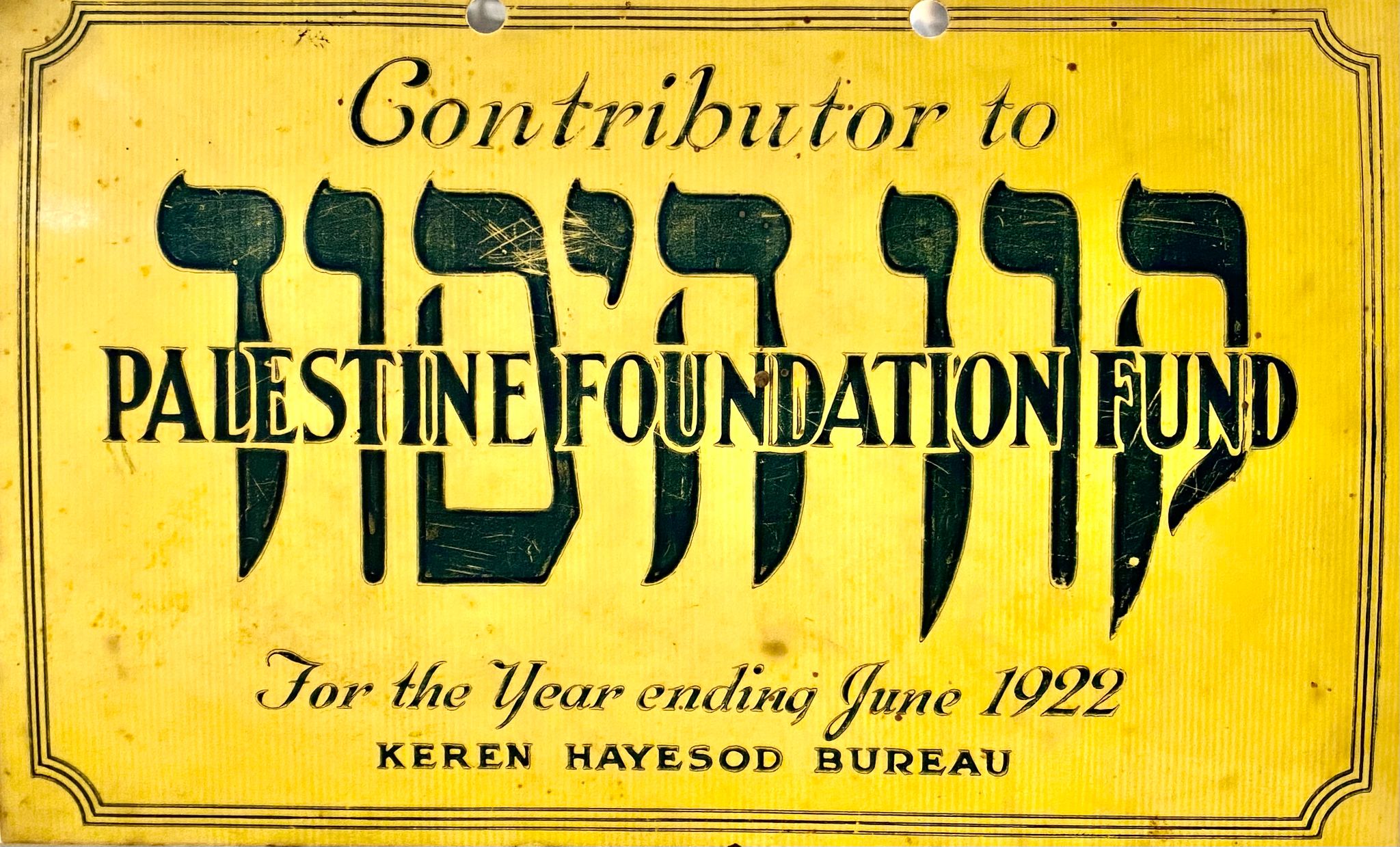
Keren Hayesod (Palestine Foundation Fund) was established in 1920 in London, England, to finance the Zionist movement’s work to bring about the return of the Jewish people to the Land of Israel. Leading figures from Chaim Weizmann to Ze’ev Jabotinsky were involved in its fundraising efforts. Keren Hayesod helped raise the seed money to establish the Hebrew University and the Israel Philharmonic Orchestra. It also helped develop the Haifa Bay suburbs to settle German Jewish refugees in the 1930s, and established dozens of communities to house the waves of immigrants after Israel’s creation. It continues to serve as a link between the people of Israel and Jewish communities around the world. This plaque recognizes a contribution made 100 years ago.

Yitzhak Rabin and Moshe Dayan were Israel’s Chief of Staff and Minister of Defence at the time of a miraculous military victory. The Western Wall of the ancient Temple had been inaccessible to Jews since 1948, as the Old City of Jerusalem was under Jordanian administration. That changed on June 7, 1967, when Jerusalem was reunited. When the war ended after six days, Israel controlled three times as much territory as it had before. Rabin was given the honour of naming the conflict: War of the Daring, War of Salvation and War of the Sons of Light were all considered. He chose The Six-Day War as it evoked the wonder of the six days of creation.

Ein Harod is a kibbutz (communal farm) founded in 1921 by Russian pioneers in northern Israel. Four years later, it was the centre of the kibbutz movement. Its members continue to live the kibbutz way of life, sharing the burden of working in its fields, industry, dairy barn and stables. This “magic lantern” slide is one of a 1920s Palestine series made by Toronto’s Charles Potter company, which also sold optical equipment and mathematical instruments. It depicts the bringing of the first fruits (bikkurim), part of the celebration of the holiday of Shavuot, which in the days of the ancient Temple—and in this picture—consisted of the land’s seven species: wheat, barley, grapes, figs, pomegranates, olives and dates.

The American Jewish Joint Distribution Committee (a.k.a. “The Joint”) was founded in 1914, initially to save the Jews of Palestine from starvation. Since then, it’s been involved in rescue, relief and renewal of Jews around the world. The Joint assisted 190,000 Jews to leave Germany in the 1930s, helped care for 420,000 Holocaust survivors after the war, and assisted 167,000 Jews reach Israel from Muslim countries. Having operated in 85 countries—including Russia, Ethiopia and the former Yugoslavia—its non-sectarian work provides a unified Jewish response to global disasters. The Joint remains active wherever Jews are in distress: currently, it’s providing critical help in Ukraine, both to those inside the country and new refugees. This label publicized a food drive for Holocaust survivors.

Chaim Nachman Bialik (1873-1934), pictured here on Israel’s 10 lira banknote from 1970, was a poet who wrote primarily in Hebrew. Ukrainian born, he earned the status of “national poet” for his depiction of Jewish life in exile—and descriptions of the future in which we controlled our own destiny. “City of Slaughter” was written after the 1903 Kishinev pogrom, in which 47 Jews were murdered: it reflects Bialik’s bitterness about the absence of justice, and it’s also critical of those who didn’t act to defend themselves. Today, his surname is still famous thanks to a distant relative, The Big Bang Theory star and Jeopardy co-host Mayim Bialik, a modern Orthodox Jew and very public supporter of Israel.

The Jewish Territorial Organization was founded in 1905 under the leadership of British author Israel Zangwill. It was dedicated to “obtaining a large tract of territory (preferably within the British Empire) wherein to found a Jewish Home of Refuge.” Could you imagine the Jewish state in a different location than where it’s located now? Alaska, Angola and Australia all had areas investigated as possibilities. The obviously unsuccessful effort faded away by the time Zangwill died in 1926. This humourous postcard, which depicts the Territorialists scanning the globe for a home, was drawn by Menachem Birnbaum—a Viennese-born artist, and the son of Nathan Birnbaum, the man who coined the term Zionism. Menachem perished in Auschwitz.

Haggadat Ha’atzmaut (or the Independence Day Haggadah) was commissioned by the State of Israel in its early days as a way to celebrate Yom Ha’atzmaut within a traditional Jewish framework. This edition from 1952 combined the structure of a Passover seder, and the Zionist spirit, to tell the story of soldiers and civillians defending and building the new country—plus the history of immigration, resistance to the British, and the declaration of independence. But after 10,000 copies were printed, it roused fierce opposition due to the secularization of the Passover liturgy, and the absence of God from the story. In response, prime minister David Ben-Gurion halted further distribution of the book.

We Will Never Die premiered at Madison Square Garden on March 9, 1943, with two performances before an audience of 40,000. Written by Ben Hecht with music by Kurt Weill, and produced by Billy Rose, its purpose was to make America do something to stop the destruction of European Jewry—which was well underway. “These are the 2 million Jewish dead of Europe today,” the show began. “The 4 million left to kill are being killed, according to plan.” After the debut, it was performed in five other cities, including before Eleanor Roosevelt in Washington, D.C. According to historian Rafael Medoff, the dramatic pageant helped shatter the curtain of silence surrounding the Holocaust, by drawing attention to a crisis that much of the mainstream news media were ignoring. Listen to the Los Angeles radio performance from July 1943:

The Montreal Expos hosted the St. Louis Cardinals at Jarry Park on April 14, 1969, for what was the first Major League Baseball game played in Canada. The team’s majority owner was Charles Bronfman, a member of the family that controlled distilling giant Seagram. Bronfman initially agreed to be one of 10 equal partners funding the US$10 million expansion fee—but as other investors withdrew, he increased his investment ensuring that Montreal (and not Buffalo) got the team. He sold the Expos in 1991—and they left Montreal to become the Washington Nationals in 2005. Among his many philanthropic initiatives, Bronfman co-founded Birthright in 1999, which has since taken over 750,000 young Jews to Israel for free.


The Partition Resolution passed by the United Nations on Nov. 29, 1947, called for the creation of a Jewish State and the end of the British Mandate. The British then started to wind down their administrative duties including ending postal services in April 1948. But, to ensure the public would still be able to send and receive mail, the provisional Jewish government in Palestine improvised and authorized the use of pre-existing Jewish National Fund stamps (overprinted with the word “Doar” or post) as valid postage stamps. These are two JNF stamps—one depicting the partition map of the independent Jewish state and the other the Negev water pipeline—which were used to send mail and postmarked by Minhelet Ha’am (People’s Administration). Israel issued its own stamps right after independence.

Moe Berg (1902-1972) played for five American League teams, and was with the Boston Red Sox when he ended his 15-year baseball career in 1939. He also spoke 10 languages—including Hebrew and Yiddish—read 10 newspapers a day, and graduated from Princeton and Columbia Law School. During the Second World War, he was a spy for the Office of Strategic Services, the predecessor to the CIA. In 1944, Berg was tasked to kill German physicist Werner Heisenberg in Switzerland if he concluded that the Germans were close to developing a nuclear bomb—but he concluded they weren’t. Paul Rudd played Berg in the 2018 biopic The Catcher Was a Spy. This baseball card is from the Jewish Major Leaguers set issued in 2003 by the American Jewish Historical Society.

The Triangle Shirtwaist Factory fire erupted on March 25, 1911, on the eighth floor of a building in Greenwich Village, New York. The death toll of garment workers was 146—who were mostly Jewish and Italian immigrant women, aged 14 to 23. Stairwells and exits had been locked in a common practice to prevent break-ins and thefts, but it meant many couldn’t escape the fire, and jumped to their deaths. Subsequently, new safety standards were introduced for factory workers, and unions were formed to fight for improved working conditions. “Mameniu” (“Dear Mother”) is an elegy for the victims which begins: “Hearts torn by the horror, the Jewish nation wrings its hands, weeping.”

Unzer Sztyme, the monthly newspaper of the Holocaust survivors in the British Zone of occupied Germany, was published in Yiddish at Bergen-Belsen’s Displaced Person’s Camp from 1945 to 1947. This illustration of “The Modern Haman” was published on March 17, 1946—the date on which Purim falls in 2022. Adolf Hitler is depicted leading a Jewish soldier on horseback: “This is what is to be done to the person the king wants to honour,” a passage from the book of Esther. The drawing depicts 10 Nazi leaders hanging from gallows like the 10 sons of Haman—the caption notes this punishment was the Jewish dream during the time of Hitler. The artist was survivor Berl Friedler who published his sketches in a book called Back from Hell.

The city of Eilat was nothing but a police station in a place called Um Rash-Rash when it was captured by the Israeli army in the last operation of the War of Independence on March 10, 1949. This important victory without a battle extended Israel to the Gulf of Aqaba and gave it a shipping route through the Red Sea. A makeshift flag—made out of a bedsheet with two stripes made of ink and a Star of David from a first-aid kit—was hoisted to signify the victory. This postcard shows Eilat shortly after its lagoon opened in 1967. Anyone who’s visited the luxury hotels and tourist attractions in the past half-century knows how much the city has changed.

Night of Stars was an annual benefit performance by New York’s film and entertainment industry to raise much needed funds for the development of Eretz Yisra’el and refugee relief and rehabilitation. The first production was in 1934, before a crowd of 45,000 at Yankee Stadium—donated for the evening by team owner Col. Jacob Ruppert—with proceeds sent to help German Jewry. Macy’s department store owner Nathan Strauss was the key driver behind the event, which inspired large-scale fundraisers by the U.S. Army and Navy, the Red Cross and others. This program is from the 1948 performance, the first after Israel’s independence.

Alfred Dreyfus was a Jewish officer in the French army who in 1894 was wrongly convicted of spying for Germany. His conviction and later exoneration became known as the Dreyfus Affair, a miscarriage of justice rooted in antisemitism, which divided France. Imprisoned on Devil’s Island for five years, Dreyfus was convicted again in a second trial, and ultimately pardoned. He was exonerated in 1906 and reinstated in the French Army, in which he served through the First World War. The yellow jersey worn by the leader of the Tour de France is related to the Dreyfus Affair—as the bicycle race was founded in 1903 by the anti-Dreyfus sports paper, L’Auto. (To celebrate Family Day, here’s Dreyfus with his children, Pierre and Jeanne.)
DIG DEEPER: Read more from the first year of Treasure Trove…
